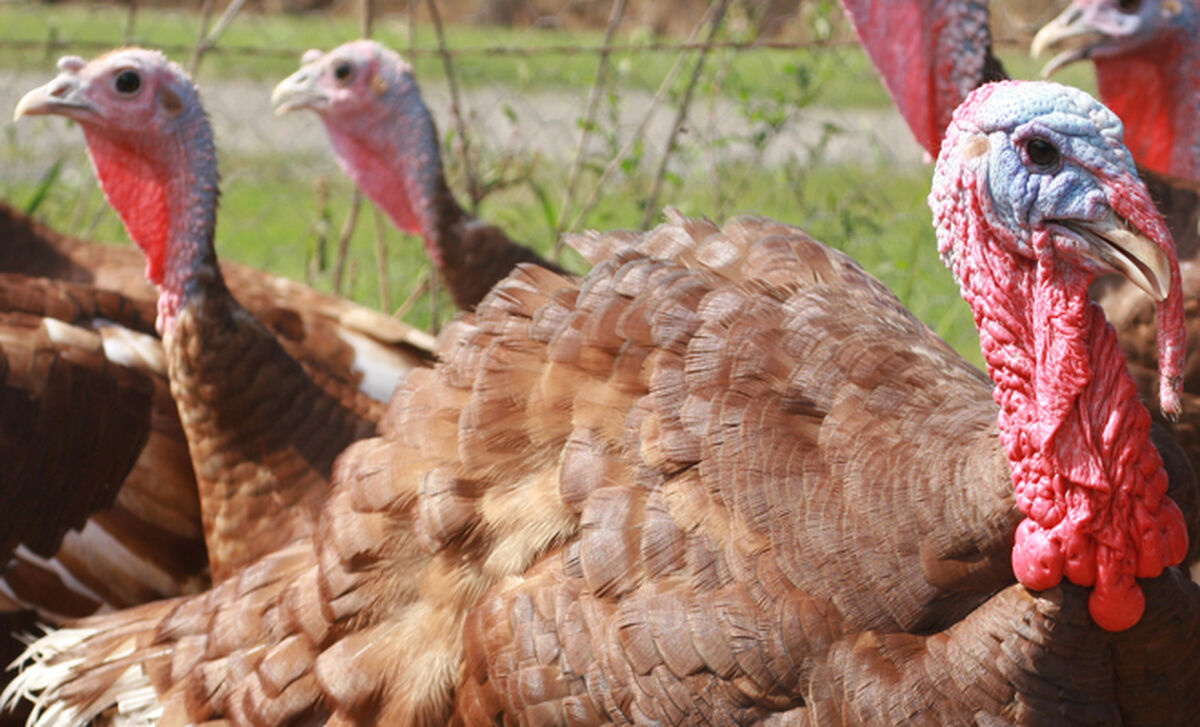Turkey History & Preparation
Read on to learn about the different breeds of turkey and the basics of preparation. Check our printable Turkey Roasting Guide for a handy primer.
Read on to learn about the different breeds of turkey and the basics of preparation. Check our printable Turkey Roasting Guide for a handy primer.

The appetite for turkey and the standardization of large-scale farming has resulted in the modern commercial turkey, which has dominated the market for the last 50 years. Breeds like the Broad Breasted Bronze and the Large White are bred to produce a lot of meat quickly. They are larger than heritage breeds or wild birds, with a higher percentage of both white meat and meat-to-bone.
This is due to breeding, diet (often the addition of growth-promoting antibiotics), lack of exercise, and water-processing. These turkeys cannot mate because of the unnaturally large breast, shorter breast bones and legs. They cannot walk normally and have very little muscle as a result. Sadly, these are the turkeys most of us are familiar with, and few have tasted turkey as it should be.
With the increasing interest in traditional foods, heirloom fruits and vegetables, and heritage breeds, demand for wild and heritage-breed turkeys has risen over the last several years. Supplying this demand has sometimes been challenging because there are few farms raising authentic heritage breeds. We offer a limited number of truly heritage breed turkeys each year so that professional and home chefs can enjoy these old-breed birds for the holidays.
What sets heritage turkey apart from the flock, are these criteria: they must be able to breed naturally, live seven to nine years, and grow slowly. They are old standard breeds, not modern experiments. Today, there are only a few heritage breeds including Standard Bronze (actually a cross between the Narragansett and Eastern wild breeds developed by early settlers in Rhode Island in the 1700s), Bourbon Red, Jersey Buff, Slate, Black Spanish, Narragansett and White Holland.
Heritage and wild turkeys thrive when raised free range, and fed natural whole-grain diets, without any antibiotics or hormones. The freedom to exercise means they have more muscle than conventional birds. Processing is often by hand instead of machine.
The result is a more intense turkey flavor with less white meat and a leaner texture that requires a tad more care in preserving moistness. Especially in the wild turkeys, the breast meat will be darker than conventional turkeys. These birds also tend to be smaller. In fact, heritage turkeys are largely unavailable in sizes over 20 lbs, and wild turkeys rarely grow over 10 lbs. When deciding what size to serve, a good rule of thumb is to plan for one pound of turkey per person.
With their richer tasting meat and moister overall texture, it's easy to assume that preparation techniques for heritage or wild turkey are exactly the same as those used for commercial birds. Nothing could be further from the truth. The fact is that these birds are leaner with a higher percentage of dark meat. This natural balance of dark to white meat actually makes preparation easier. Since white meat always cooks faster than dark, the closer the ratio, the easier it is to roast evenly. Brining, barding and basting are common techniques in preparing a tasty heritage bird.
The breast meat is smaller (after all, it hasn't been artificially enlarged) and needs protection during cooking. Covering the breast meat with aluminum foil, or cheesecloth soaked in cooking oil while cooking is strongly advised. Remove the covering about 30 minutes before the turkey is done so the breast will brown. Frequent basting is a must unless you rub truffle butter or olive oil under the skin over the breast, which makes the birds self-basting. Because they are leaner and tend to be smaller, cooking at low temperatures for a longer time is also suggested.